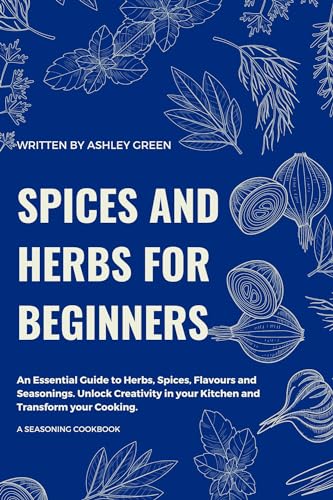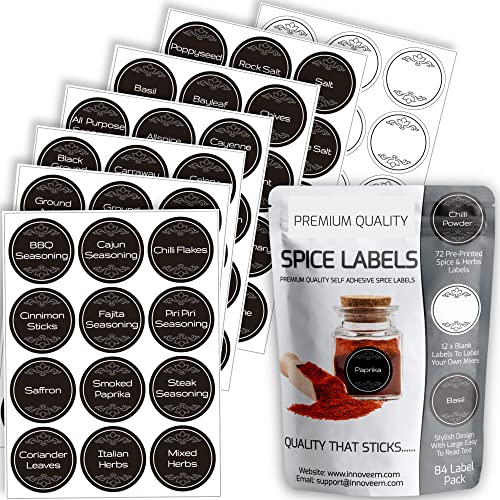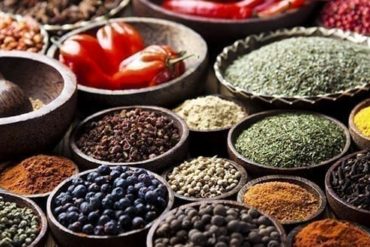Anise, otherwise known as aniseed, is a mild, sweet-tasting spice, with a flavour comparable to liquorice. Anise is perfect for cakes, fruit pies, chutneys or relish, and adds an interesting twist when the seeds are sprinkled over fruit salads.
Allspice is a pungent spice with notes of cloves, nutmeg and cinnamon. Allspice can be used in both sweet and savoury use, and is traditionally used in Jamaican jerk seasoning. It can also be used in cakes, sweet pies and cookies, and in addition to this, you can add it to your pepper grinder to give a unique seasoning.
Basil is a pungent, slightly sweet, pepper-tasting herb comparable to oregano and thyme. The herb is used in traditional Italian and Thai cooking. Basil compliments tomato but can also be used to add sweet, minty notes to meats like chicken, lamb or fish.
Bay leaves have a sharp, rather bitter taste, and are quite pungent. Traditionally used in American cooking for soups, stews and meats, these leaves can also be used in spaghetti or pasta sauces, and also be placed on meats whole to be cooked. Ensure you remove the bay leaves before eating the food however, as they can taste bitter and be difficult to chew.
Caraway seeds have a sweet, slightly tangy taste and a pungent aroma. Indigenous to Asia and parts of Europe, caraway seeds are thought to be the oldest used seasoning in Europe, with writings from the 17th century stating that they were used on cakes, breads and with fruits. Caraway seeds mix well with garlic and bring out the taste of sauerkraut nicely. Caraway seeds can also be toasted and sprinkled lightly over cheese dishes.
Cardamom is an intensely aromatic spice with a unique taste. Indigenous to India, Nepal and Bhutan, this spice works well for both savoury and sweet dishes. Although traditionally used in curries and added to breads, this versatile spice can be added to a variety of pies and pastries, or consumed the ‘Arabic way’ by adding some to your coffee before it is brewed.
Cayenne pepper is a very hot spice that doesn’t have much aroma and is traditionally used in Indian and south American cooking. Cayenne pepper can be added to sauces and dips for that extra ‘kick’.
Chives have a subtle onion flavour with notes of garlic and are perfect for use in dishes when onion is too overpowering, such as with fish. Chives should be added to hot dishes at the last minute, or their flavour is diminished, however. Chives’ subtle flavours work perfectly in dips.
Cinnamon is a sweet, hot spice with a rich, warm aroma. It is one of the most utilised spices, as it can be used in both sweet and savoury dishes. Cinnamon is commonly seen in desserts and baked goods such as cookies, cakes and muffins, as well as a wide use in meals containing chicken and lamb.
Cloves are a sweet-tasting spice with a sharp aroma, comparable to cinnamon. This spice is commonly ground up and sprinkled on baked goods, especially those which contain stewed fruit. Whole cloves can also be left in food while they’re being cooked, but they should be taken out before being consumed as they can be overpowering and bitter.
Coriander is an earthy, mild seed, with a lemony taste that is from the same plant of cilantro. It is one of the three commonly used components when making curry powders, with the other two being Cumin and Turmeric. In addition to its use in curry blends, it works well with soups and vegetable stews, and can also add flavour to tomato based dishes such as lasagne and pasta. For a unique steak seasoning, add coriander to some black peppercorns, crushing them and adding them to the raw steak before cooking it.
Cumin, the pale green seed native to India, is a unique-tasting spice with a slight bitter note. It is very commonly used in India and is one of the main components of curry powder. Cumin can be added to spicy meat stews and sauces, and works especially well in barbeque marinades and tomato based foods to add a zesty citrus flavour.
Curry powder is a blend of spices that have been used to flavour Indian curries for hundreds of years. The main components of curry powder are Turmeric, chilli powder, ground coriander, ground cumin, ground ginger, and pepper, but spices can be added and taken away.
Dill seed/weed has a mild taste and is comparable to caraway, but milder. Dill seed works well when used in casseroles and on salads.
Fennel seed has a liquorice-like taste, and is comparable to Anise, although less pungent. Traditionally used in Italian cooking, fennel seeds can be added to tomato sauces while they’re being cooked, and is a welcome addition to tomato based dishes such as pizza, lasagne and pasta.
Garlic, which has a pungent, spicy flavour, that sweetens after cooking, is an extremely popular spice which is used extensively in Italian, Indian, Chinese and Mexican foods. Garlic can be minced and used in soups, stews and tomato bases. Garlic powder can also be added to various meats before eating, and can also be used in creamy dips and sauces.
Ginger is an aromatic, pungent and spicy root, that is used extensively in Asian and Caribbean cooking, and can be used in both sweet and savoury dishes. Most commonly used to make gingerbread, this spice also works well with apple desserts.
Mace, the red casing around nutmeg, has a taste similar, but subtler, to that of nutmeg. Mace can be used on sweet or savoury foods, and is a welcome addition to any sweet baked dish.
Marjoram is a sweet, sharp herb, almost identical to oregano. Indigenous to the Mediterranean, the subtle taste means it should be crushed in a mortar and pestle, or in your hands, and works well with meats such as beef, lamb and veal. Combine marjoram with thyme, basil or parsley to create a unique-tasting meat seasoning.
Mustard seeds have no aroma, but when ground and mixed with water, an intense spice comes out. Mustard is best used in meat, pickle and chutney flavouring.
Nutmeg, which has a nutty, sweet flavour, is thought of as a stronger version of mace, as they are both grown on the same tree. The sweet spice is commonly used In eggnog, baked goods like cakes and muffins, but can also be sprinkled into curries and onto chicken for a unique seasoning.
Oregano is a slightly bitter, pungent herb that has a hint of sweetness and is comparable to thyme or basil. Oregano is indigenous to the Mediterranean, and is widely popular in Greek and Italian cuisine, making it perfect for pizza and pasta sauces. In addition to tomato based foods, oregano works very well with egg and cheese, making it perfect to sprinkle over omelettes. Oregano should be crushed in a mortar and pestle or by hand, and can make a great addition to ground meat dishes.
Paprika, made from the ground, dried remains of the capsicum pepper, is a slightly sweet spice that is widely used in North and South American cooking, as well as in Spanish cuisine. Paprika is an excellent accompaniment to any savoury dish. It works especially well with eggs and can be added to butter or oil to drizzle over fish, chicken or turkey.
Parsley has a mild, fresh taste. The herb is commonly used in Middle Eastern, European and Brazilian cooking, and lends itself nicely to vegetable dishes, salads, stews and casseroles.
Peppercorns are a dried berry which are indigenous to India and Asia. This widely-used table condiment has a strong taste and a pungent aroma which is suited to most dishes. It is used widely in nearly all cooking, and can be added to nearly anything, with the exception of sweet foods.
Poppy seeds have a nutty taste which make them perfect to add to breads, biscuits, pancakes waffles and cakes to add some texture without overpowering them. Poppy seeds can also be added to salads and go well in noodle dishes.
Red pepper spice is a very hot spice with a pungent aroma that is traditionally used in Mexican, Thai and Indian cooking. This ground up spice lends itself nicely to many different dishes when a bit of an extra ‘kick’ is needed, and works especially well when infused with an oil to make a pouring chilli oil that can be drizzled on nearly anything.
Rosemary has a strong pine-like flavour and a pungent aroma. This herb is thought to have originated in the Mediterranean, and traditionally works well seasoning chicken, lamb and stuffing. Rosemary can also be used in meat or vegetable stews and lends itself nicely to tomato based dishes and fish.
Saffron, which is native to the Mediterranean, has a delicate subtle taste, although some would say it is quite bitter and pungent. Traditionally, saffron is used in Spanish dishes such as paella, French bouillabaisse and various Middle Eastern dishes. Saffron’s taste lends itself well to fish dishes such as fish stew, fish curry and fish soup, but can also be used to season chicken and rice.
Sage is an aromatic herb with woody, slightly bitter notes. It was used extensively by the Romans and was thought to be one of the first herbs used as medicine. Although best known for its use in sausages and stuffing, sage also works wonders on meat and fish such as swordfish, tuna, turkey, steak and chicken.
Thyme is a slightly minty, aromatic herb that is indigenous to Europe, North Africa and Asia. Thyme works well over meats such as lamb, beef and pork, but can also be added to cheese and egg dishes such as omelettes or tomato dishes such as pasta, pizza or lasagne.
Turmeric is an aromatic, mild, citrusy root, indigenous to southeast Asia and comparable to ginger. As one of the main spices needed for curry powder, this spice is widely used in traditional Indian cooking. It can also be added to mustard blends and relishes or even chicken dishes to add a splash of Indian flavour.









